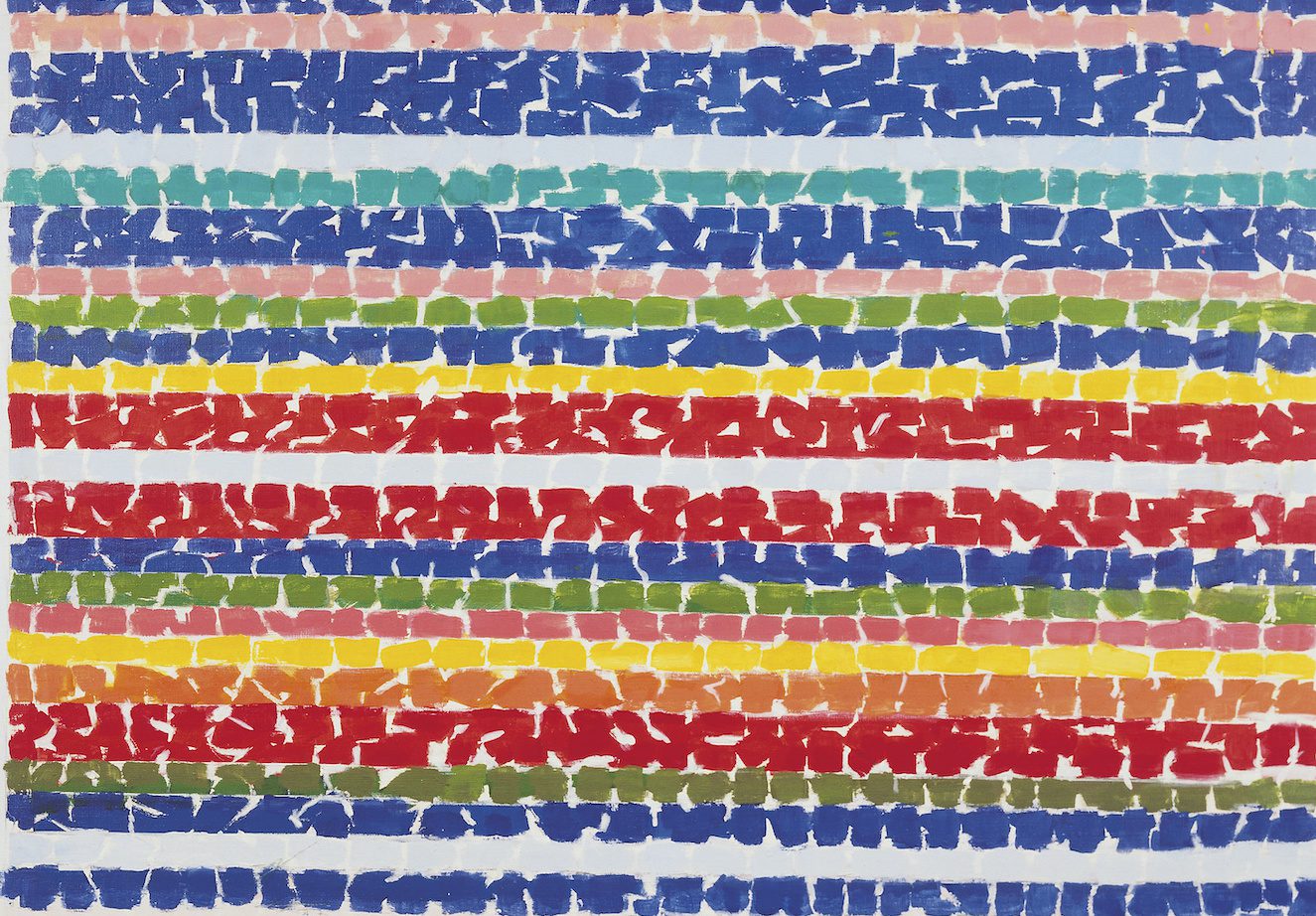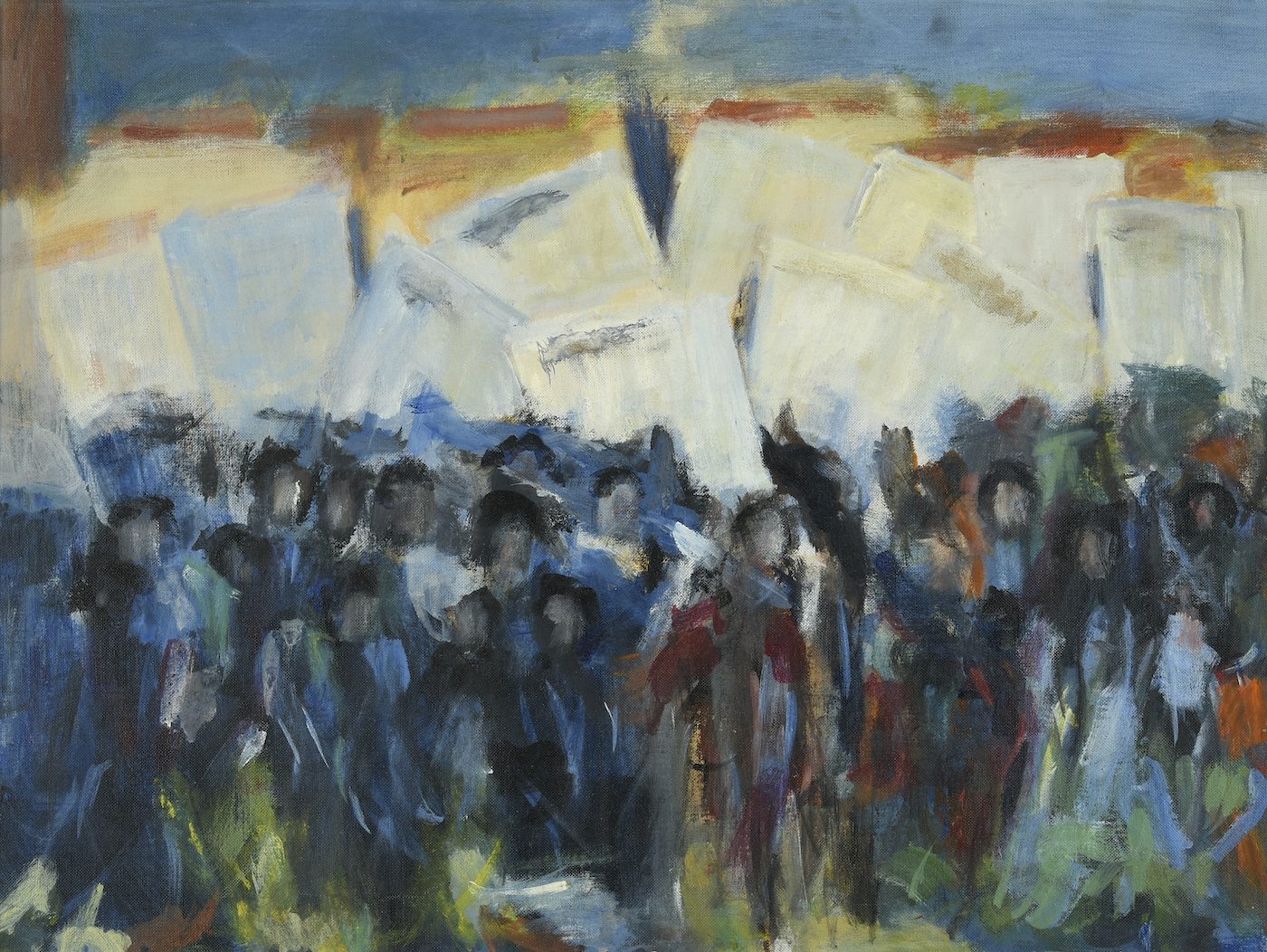Après la guerre, de nombreux artistes de couleur se sont vus rejetés par le monde de l’art occidental malgré l’importance et l’originalité de leurs apports – mais ont néanmoins poursuivi leurs efforts. Depuis une dizaine d’années, les institutions occidentales s’ouvrent à ce que ces artistes nous ont laissé. Elles organisent enfin les premières rétrospectives. Et naturellement, les marchés suivent. Notre série retrace leurs parcours, met en lumière leurs évolutions artistiques et ce qui les fait avancer par rapport au monde qui les entoure. Ici, nous faisons le portrait d'Alma W. Thomas, admiratrice constante des trésors du monde naturel et première femme artiste afro-américaine à avoir bénéficié d’une exposition personnelle au Whitney Museum of American Art.

Alma Thomas, Air View of Spring Nursery (Detail), 1966. Acrylic on canvas. The Columbus Museum
Au cours des douze dernières années de sa vie, Alma W. Thomas (1891-1978) s’est attelée à repousser les limites de l’art abstrait. Animée par le désir de réaliser des œuvres différentes de tout ce qu’elle avait rencontré auparavant, Thomas n’a cessé, à travers sa pratique, de stimuler et de remettre en question sa propre imagination créatrice. Elle est notamment reconnue pour ses touches de peinture distinctives, qui forment d’éclatants rayons de couleur sur la toile, un style développé sur le tard. Son œuvre capture à merveille la vivacité du monde naturel, qui n’a jamais cessé de la fasciner. Depuis ses débuts fulgurants en 1966, plusieurs grandes institutions artistiques ont su reconnaître son talent extraordinaire à travers l’acquisition et l’exposition de ses œuvres.
Née de parents de la classe moyenne en 1891, Thomas grandit dans une maison victorienne à Columbus, dans l’État de Géorgie. Dès son plus jeune âge, sa vie en Géorgie et ses fréquentes visites dans l’État voisin de l’Alabama l’ont initiée à la nature et à ses beautés. Dans son livre A Life in Art: Alma Thomas, 1891-1978 (1981), Merry A. Forresta écrit que la jeune Thomas « réagissait avec un intérêt et une perception hors du commun à la végétation luxuriante et aux sonorités musicales de la nature qui peuplaient [son] environnement ». Malgré ces paysages idylliques, ses parents aspiraient à de meilleures conditions de vie pour leur famille. En 1907, le foyer s’installe à Washington D.C., dans l’espoir d’échapper à la violence raciale exercée sur les personnes Noires dans le Sud des États-Unis, et trouver sécurité et opportunités. À leur arrivée, la capitale du pays était organisée selon une ségrégation juridique ; les personnes Noires américaines se voyaient refuser l’accès à la plupart des bibliothèques, théâtres, musées et universités.
Toute sa vie, Thomas s’est consacré à son éducation artistique et à la stimulation de son imagination et de sa créativité. En 1924, elle est diplômée de l’université Howard, elle est la première étudiante issue du programme des beaux-arts nouvellement créé. Dix ans plus tard, elle obtient une maîtrise en sciences de l’éducation à l’université de Columbia. Tout en enseignant l’art dans les écoles publiques de Washington D.C., Thomas continue à nourrir ses propres intérêts et curiosités artistiques. En 1948, elle rejoint le Little Paris Group, un atelier d’art visuel formé autour de la peintre et enseignante Lois Mailou Jones. Ses membres – des enseignant·es en art et des fonctionnaires – critiquaient ensemble les œuvres proposées et organisaient des expositions publiques et collectives.

Alma Thomas, Sketch for March on Washington, ca. 1963. Oil on canvas board. The Columbus Museum
Columbus, GA
Dans les années 1950 et 1960, Thomas suit des cours d’art à la American University. La peinture March on Washington(1963) illustre son style et ses sujets privilégiés de l’époque. Dans cette œuvre, Thomas représente une foule d’individus dans un style expressionniste, où les corps et les signes sont à la fois abstraits et encore reconnaissables. Les nuances foncées de bleu et de rouge donnent à l’œuvre une tonalité sombre qui contraste avec sa palette de couleurs plus tardive.
À l’âge de soixante-neuf ans, après trente-cinq ans de carrière comme professeure d’art, Thomas prend sa retraite. De 1960 à sa mort en 1978, elle réalise ses œuvres les plus importantes. À l’American University, elle fait connaissance avec la Washington Color School, un groupe réunissant Morris Louis, Kenneth Noland et Gene Davis, connu pour privilégier la couleur sur la forme et la structure. Thomas s’inspire de l’usage chromatique et géométrique du groupe pour inventer son propre style. En appliquant des touches de peinture sous forme de petits points, ses œuvres dégagent un sentiment de structure, de légèreté, d’improvisation bien qu’elle accorde une attention méticuleuse à l’emplacement et au choix des couleurs. Avec des compositions telles que Air View of a Spring Nursery (1966), Thomas manifeste une admiration permanente pour les trésors du monde naturel. Cette toile illustre ce qui est devenu sa signature : des taches rectangulaires de bleus, de rouges et de jaunes vifs composent un spectre de couleurs qui traverse horizontalement la toile. Elle abandonne entièrement les formes définies du paysage pour mieux exprimer la vivacité et l’harmonie de la nature à travers sa maîtrise de la couleur.
Sa série Space Painting traduit l’émerveillement et le frisson de l’exploration spatiale. Comme dans ses œuvres inspirées de la nature, la conception et le traitement exceptionnels de la couleur par Thomas sont clairement perceptibles dans l’œuvre Blast Off (1970). Des rouges et des bleus profonds sont posés les uns contre les autres sur la toile, suscitant une sensation de tension. Par contraste, une bande de roses et de jaunes clairs divisant le triangle en deux évoque l’énergie et le mouvement.
Ce nouveau style artistique apparaît nettement dans sa première exposition personnelle, à l’université Howard en 1966. L’exposition fait connaître ses innovations créatives, mais en tant qu’artiste afro-américaine évoluant à une époque où les personnes Noires étaient discriminées et marginalisées par de nombreux musées et galeries, la présentation de ses œuvres au sein de grandes institutions se heurte à d’importants obstacles. La revendication croissante de l’égalité raciale dans le domaine des arts et à l’échelle nationale, à travers les mouvements des droits civiques et du Black Power, fait évoluer les attitudes et les pratiques. En 1972, Thomas est la première femme afro-américaine à présenter une exposition individuelle au Whitney Museum of American Art. Lors d’une interview en relation avec l’exposition, Thomas déclare : « Aller au musée était l’une des choses qui nous était interdite, et encore moins d’imaginer y accrocher nos œuvres ! Les temps ont bien changé. Il suffit de me regarder aujourd’hui ! »
Depuis sa mort en 1978, l’artiste a fait l’objet de plusieurs expositions importantes, et ses œuvres font désormais partie de collections remarquables telles que celles du National Museum of Women in the Arts, du Metropolitan Museum et de la White House Historical Association. La voix artistique singulière de Thomas, sa virtuosité chromatique et son enthousiasme pour la vie sont à l’honneur dans l’exposition Alma W. Thomas: Everything is Beautiful, présentée au Chrysler Museum jusqu’au 3 octobre 2021.
Texte par Leslie Rose.
Traduit par Gauthier Lesturgie.
INVENTER SON PROPRE TERRAIN
DERNIERS ARTICLES PUBLIÉS
More Editorial